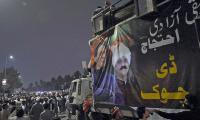The tragedy of the Afghan war is that it has several villains but not many heroes. However, this June was different. The three-day Eid ceasefire that allowed the Afghan National Security Forces (ANSF) and the Afghan Taliban to pray and celebrate Eidul Fitr together with the general public was unprecedented.
Despite its short-lived nature, the Eid truce revived modest hopes of jumpstarting the on-and-off peace process. It is an important confidence-building measure and has the potential to pave way for larger peace negotiations.
First, the three-day truce was purely an Afghan-initiated, led and owned process. Symbolically, it has opened the imaginative space for peace and will give the National Unity Government (NUG) and Afghan Taliban the confidence that despite all odds, peace is achievable, provided a political will and sincerity.
In 17 years, the war-weary Afghans have experienced peace in the middle of the peak fighting season for the first time. President Ashraf Ghani’s bold diplomatic move of offering a unilateral ceasefire to the Afghan Taliban and willingness to discuss the presence of the US troops in Afghanistan has put the onus on the Afghan Taliban to reciprocate.
Second, the Eid ceasefire was the first publicly acknowledged Confidence Building Measure (CBM) between the NUG and Taliban. It ended years of bad blood and animosity that will facilitate future peace talks. The euphoric manner in which the people in Afghanistan, including the Taliban commanders and fighters, welcomed the peace initiative shows that people have become war-weary and are hungry for peace. Though the Afghan Taliban did not extend the ceasefire, the temporary lull in violence has created a grassroots constituency for peace. This constituency needs to be further strengthened and expanded.
The truce coincided with the entry of the Helmand peace marchers into Kabul who travelled over 750 kilometres in the sweltering heat to demand peace and an end to hostilities. The Taliban fighters who celebrated Eid in a peaceful environment with their families will create a bottom-up pressure on the Taliban’s executive council to reconsider its approach of fighting endlessly.
Third, the three-day ceasefire proved to the US, NUG and other regional stakeholders that if the Taliban’s executive council signed an agreement, other associated insurgent factions will abide by it. The ceasefire removed doubts and confusions about the Afghan Taliban’s organisational coherence.
In 2015, former Taliban chief Akhtar Muhammad Mansour failed to create a consensus among insurgent factions to initiate peace talks. The Taliban field commanders and fighters were opposed to the talks and the Taliban’s executive council feared that negotiations could divide the insurgent movement. This is why, despite his reputation as a political negotiator, Mansour failed to initiate peace talks.
Finally, now that the psychological barrier of the violence halting for some time has been overcome, the debate will inevitably turn towards America’s withdrawal from Afghanistan. The time and manner of this exit will determine the future trajectory of war and peace in Afghanistan. President Ghani’s willingness to discuss the timeframe of the US’ exit indicates that the endgame narrative of the Afghan conflict has matured enough to confront the elephant in the room.
Encouraged by the success of the Eid ceasefire, US Secretary of State Mike Pompeo has indicated that the Trump administration is ready to discuss with the Taliban the role of the US and international forces in the peace talks.
Since the launch of the Trump administration’s new Afghan policy, which gave more powers to the US military commanders in Afghanistan, the situation has turned from bad to worse. The intensified airstrikes have done little to nothing to reverse the momentum of the Taliban’s battlefield advantages and territorial gains. The Afghan Taliban now control over 40 percent of Afghanistan’s territory.
After eliminating Mullah Fazlullah –Pakistan’s most-wanted terrorist – in a drone attack in the eastern Kunar province, the US is once again banking on Pakistan to pull it out of the Afghan quagmire. On June 22, US Defence Secretary James Mattis acknowledged the role of the US forces in neutralising Fazlullah, and urged Pakistan to help in the Afghan peace process.
The thaw in Pak-Afghan relations prior to the restoration of the Afghan peace talks is a positive sign as well. The recent high-powered trip of Army Chief General Qamar Javed Bajwa to Kabul and the subsequent visit of Afghanistan’s Interior Minister Wais Ahmad Barmak, National Security Adviser Mohammad Hanif Atmar and intelligence chief Masoum Stanikzai showed the revival of a working relationship between the two countries.
Earlier, the creation of the Pak-Afghan joint working group and the restraint shown by both sides from unnecessarily criticising each other publicly also helped create an enabling environment to restart the peace process. Pakistan’s military leadership has been cautious in its assurances to Kabul and has only pledged to bring the Taliban to the negotiation table without taking any responsibility of the outcome.
Ahead of Afghanistan’s parliamentary elections, these developments have brought the Afghan peace process at a crossroads. If a breakthrough is not achieved before the elections then all stakeholders will have to wait for the elections to conclude to engage with the newly elected Afghan government. However, this is fraught with multiple risks. Holding peaceful elections and ensuring a smooth transition of power in Afghanistan can be a contentious and long-drawn out process. Additionally, if Ghani is not re-elected it will be unclear whether the new president will be interested in holding peace talks or not.
Even if the new president is willing to engage the Taliban politically, his immediate focus would be to consolidate his position, build his team and establish his authority before resuming the peace talks. This is why the opportunity created by the Eid ceasefire should not be squandered.
The writer is an associate researchfellow at the S Rajaratnam School of International Studies, Singapore.
Email: isabasit@ntu.edu.sg
Data, today, defines how we make decisions with tools allowing us to analyse experience more precisely
But if history has shown us anything, it is that rivals can eventually unite when stakes are high enough
Imagine a classroom where students are encouraged to question, and think deeply
Pakistan’s wheat farmers face unusually large pitfalls highlighting root cause of downward slide in agriculture
In agriculture, Pakistan moved up from 48th rank in year 2000 to an impressive ranking of 15th by year 2023
Born in Allahabad in 1943, Saeeda Gazdar migrated to Pakistan after Partition







